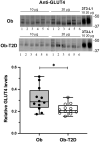Diabetes is accompanied by changes in the levels of proteins involved in endosomal GLUT4 trafficking in obese human skeletal muscle
- PMID: 35964329
- PMCID: PMC9471587
- DOI: 10.1002/edm2.361
Diabetes is accompanied by changes in the levels of proteins involved in endosomal GLUT4 trafficking in obese human skeletal muscle
Abstract
Introduction: The regulated delivery of the glucose transporter GLUT4 from intracellular stores to the plasma membrane underpins insulin-stimulated glucose transport. Insulin-stimulated glucose transport is impaired in skeletal muscle of patients with type-2 diabetes, and this may arise because of impaired intracellular trafficking of GLUT4. However, molecular details of any such impairment have not been described. We hypothesized that GLUT4 and/or levels of proteins involved in intracellular GLUT4 trafficking may be impaired in skeletal muscle in type-2 diabetes and tested this in obese individuals without and without type-2 diabetes.
Methods: We recruited 12 participants with type-2 diabetes and 12 control participants. All were overweight or obese with BMI of 25-45 kg/m2 . Insulin sensitivity was measured using an insulin suppression test (IST), and vastus lateralis biopsies were taken in the fasted state. Cell extracts were immunoblotted to quantify levels of a range of proteins known to be involved in intracellular GLUT4 trafficking.
Results: Obese participants with type-2 diabetes exhibited elevated fasting blood glucose and increased steady state glucose infusion rates in the IST compared with controls. Consistent with this, skeletal muscle from those with type-2 diabetes expressed lower levels of GLUT4 (30%, p = .014). Levels of Syntaxin4, a key protein involved in GLUT4 vesicle fusion with the plasma membrane, were similar between groups. By contrast, we observed reductions in levels of Syntaxin16 (33.7%, p = 0.05), Sortilin (44%, p = .006) and Sorting Nexin-1 (21.5%, p = .039) and -27 (60%, p = .001), key proteins involved in the intracellular sorting of GLUT4, in participants with type-2 diabetes.
Conclusions: We report significant reductions of proteins involved in the endosomal trafficking of GLUT4 in skeletal muscle in obese people with type 2 diabetes compared with age- and weight-matched controls. These abnormalities of intracellular GLUT4 trafficking may contribute to reduced whole body insulin sensitivity.
Keywords: clinical medicine; diabetes; metabolic disease.
© 2022 The Authors. Endocrinology, Diabetes & Metabolism published by John Wiley & Sons Ltd.
Conflict of interest statement
The authors declare they have no competing interests.
Figures





Similar articles
-
Insulin signalling and GLUT4 trafficking in insulin resistance.Biochem Soc Trans. 2023 Jun 28;51(3):1057-1069. doi: 10.1042/BST20221066. Biochem Soc Trans. 2023. PMID: 37248992 Free PMC article. Review.
-
Gene expression of GLUT4 in skeletal muscle from insulin-resistant patients with obesity, IGT, GDM, and NIDDM.Diabetes. 1992 Apr;41(4):465-75. doi: 10.2337/diab.41.4.465. Diabetes. 1992. PMID: 1535055
-
Impairment of insulin-stimulated GLUT4 translocation in skeletal muscle and adipose tissue in the Tsumura Suzuki obese diabetic mouse: a new genetic animal model of type 2 diabetes.Eur J Endocrinol. 2001 Dec;145(6):785-90. doi: 10.1530/eje.0.1450785. Eur J Endocrinol. 2001. PMID: 11720905
-
DOC2B promotes insulin sensitivity in mice via a novel KLC1-dependent mechanism in skeletal muscle.Diabetologia. 2019 May;62(5):845-859. doi: 10.1007/s00125-019-4824-2. Epub 2019 Feb 1. Diabetologia. 2019. PMID: 30707251 Free PMC article.
-
Role of SNARE's in the GLUT4 translocation response to insulin in adipose cells and muscle.J Basic Clin Physiol Pharmacol. 1998;9(2-4):153-65. doi: 10.1515/jbcpp.1998.9.2-4.153. J Basic Clin Physiol Pharmacol. 1998. PMID: 10212832 Review.
Cited by
-
Clinicopathologic significance of FUT8, STX4, and calpain2 expression in ovarian cancer.Am J Transl Res. 2025 Jan 15;17(1):144-161. doi: 10.62347/SQKL1957. eCollection 2025. Am J Transl Res. 2025. PMID: 39959200 Free PMC article.
-
The importance of caveolin as a target in the prevention and treatment of diabetic cardiomyopathy.Front Immunol. 2022 Nov 2;13:951381. doi: 10.3389/fimmu.2022.951381. eCollection 2022. Front Immunol. 2022. PMID: 36405687 Free PMC article. Review.
-
Reduced Tyrosine and Serine-632 Phosphorylation of Insulin Receptor Substrate-1 in the Gastrocnemius Muscle of Obese Zucker Rat.Curr Issues Mol Biol. 2022 Nov 29;44(12):6015-6027. doi: 10.3390/cimb44120410. Curr Issues Mol Biol. 2022. PMID: 36547071 Free PMC article.
-
GLUT4 dispersal at the plasma membrane of adipocytes: a super-resolved journey.Biosci Rep. 2023 Oct 31;43(10):BSR20230946. doi: 10.1042/BSR20230946. Biosci Rep. 2023. PMID: 37791639 Free PMC article. Review.
-
Insulin signalling and GLUT4 trafficking in insulin resistance.Biochem Soc Trans. 2023 Jun 28;51(3):1057-1069. doi: 10.1042/BST20221066. Biochem Soc Trans. 2023. PMID: 37248992 Free PMC article. Review.
References
-
- Warram JH, Martin BC, Krolewski AS, Soeldner JS, Kahn CR. Slow glucose removal rate and hyperinsulinemia precede the development of type II diabetes in the offspring of diabetic parents. Ann Intern Med. 1990;113:909‐915. - PubMed
-
- DeFronzo RA, Jacot E, Jequier E, Maeder E, Wahren J, Felber JP. The effect of insulin on the disposal of intravenous glucose. Results from indirect calorimetry and hepatic and femoral venous catheterization. Diabetes. 1981;30:1000‐1007. - PubMed
-
- Gould GW, Brodsky FM, Bryant NJ. Building GLUT4 vesicles: CHC22 Clathrin's human touch. Trends Cell Biol. 2020;30:705‐719. - PubMed
Publication types
MeSH terms
Substances
LinkOut - more resources
Full Text Sources
Medical

